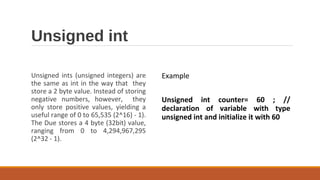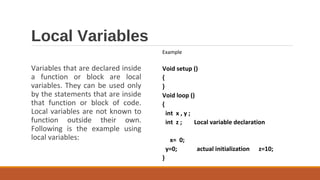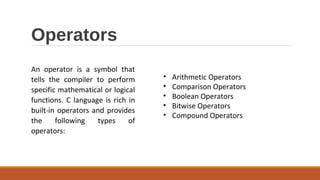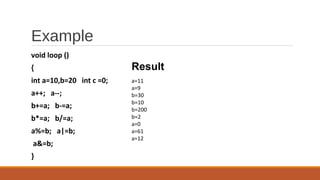Programming in Arduino (Part 1)
- 1. Programming in Arduino DATA TYPES IN C REFERS TO AN EXTENSIVE SYSTEM USED FOR DECLARING VARIABLES OR FUNCTIONS OF DIFFERENT TYPES. THE TYPE OF A VARIABLE DETERMINES HOW MUCH SPACE IT OCCUPIES IN THE STORAGE AND HOW THE BIT PATTERN STORED IS INTERPRETED.
- 2. Data Types void Boolean char Unsigned char byte int Unsigned int word long Unsigned long short float double array String-char array String- object
- 3. Void The void keyword is used only in function declarations. It indicates that the function is expected to return no information to the function from which it was called. Example Void Loop ( ) { // rest of the code }
- 4. Boolean A Boolean holds one of two values, true or false. Each Boolean variable occupies one byte of memory. Example boolean val = false ; // declaration of variable with type boolean and initialize it with false boolean state = true ; // declaration of variable with type boolean and initialize it with false
- 5. Char A data type that takes up one byte of memory that stores a character value. Character literals are written in single quotes like this: 'A' and for multiple characters, strings use double quotes: "ABC". Example Char chr_a = ‘a’ ;//declaration of variable with type char and initialize it with character a Char chr_c = 97 ;//declaration of variable with type char and initialize it with character 97 • However, characters are stored as numbers. You can see the specific encoding in the ASCII chart. This means that it is possible to do arithmetic operations on characters, in which the ASCII value of the character is used. For example, 'A' + 1 has the value 66, since the ASCII value of the capital letter A is 65.
- 7. Unsigned Char Unsigned char is an unsigned data type that occupies one byte of memory. The unsigned char data type encodes numbers from 0 to 255. Example Unsigned Char chr_y = 121 ; // declaration of variable with type Unsigned char and initialize it with character y
- 8. Byte A byte stores an 8-bit unsigned number, from 0 to 255. Example byte m = 25 ;//declaration of variable with type byte and initialize it with 25
- 9. Int Integers are the primary data-type for number storage. int stores a 16-bit (2byte) value. This yields a range of -32,768 to 32,767 (minimum value of -2^15 and a maximum value of (2^15) - 1). Example int counter = 32 ;// declaration of variable with type int and initialize it with 32 The int size varies from board to board. On the Arduino Due, for example, an int stores a 32-bit (4- byte) value. This yields a range of -2 , 147,483,648 to 2,147,483,647 (minimum value of -2^31 and a maximum value of (2^31) - 1).
- 10. Unsigned int Unsigned ints (unsigned integers) are the same as int in the way that they store a 2 byte value. Instead of storing negative numbers, however, they only store positive values, yielding a useful range of 0 to 65,535 (2^16) - 1). The Due stores a 4 byte (32bit) value, ranging from 0 to 4,294,967,295 (2^32 - 1). Example Unsigned int counter= 60 ; // declaration of variable with type unsigned int and initialize it with 60
- 11. Word On the Uno and other ATMEGA based boards, a word stores a 16- bit unsigned number. On the Due and Zero, it stores a 32-bit unsigned number. Example word w = 1000 ;//declaration of variable with type word and initialize it with 1000
- 12. Long Long variables are extended size variables for number storage, and store 32 bits (4 bytes), from 2,147,483,648 to 2,147,483,647. Example Long velocity= 102346 ;//declaration of variable with type Long and initialize it with 102346
- 13. Unsigned Long Unsigned long variables are extended size variables for number storage and store 32 bits (4 bytes). Unlike standard longs, unsigned longs will not store negative numbers, making their range from 0 to 4,294,967,295 (2^32 - 1). Example Unsigned Long velocity = 101006 ;// declaration of variable with type Unsigned Long and initialize it with 101006
- 14. Short A short is a 16-bit data-type. On all Arduinos (ATMega and ARM based), a short stores a 16-bit (2- byte) value. This yields a range of -32,768 to 32,767 (minimum value of -2 ^15 and a maximum value of (2^15) - 1). Example short val= 13 ;//declaration of variable with type short and initialize it with 13
- 15. Float Data type for floating-point number is a number that has a decimal point. Floatingpoint numbers are often used to approximate the analog and continuous values because they have greater resolution than integers. Floating-point numbers can be as large as 3.4028235E+38 and as low as 3.4028235E+38 . They are stored as 32 bits (4 bytes) of information Example float num = 1.352;//declaration of variable with type float and initialize it with 1.352
- 16. Double On the Uno and other ATMEGA based boards, Double precision floating-point number occupies four bytes. That is, the double impl ementation is exactly the same as the float, with no gain in precision. On the Arduino Due, doubles have 8-byte (64 bit) precision. Example double num = 45.352 ;// declaration of variable with type double and initialize it with 45.352
- 17. Variable & Constant Variables in C programming language, which Arduino uses, have a property called scope. A scope is a region of the program and there are three places where variables can be declared. They are: Inside a function or a block, which is called local variables. In the definition of function parameters, which is called formal parameters. Outside of all functions, which is called global variables.
- 18. Local Variables Variables that are declared inside a function or block are local variables. They can be used only by the statements that are inside that function or block of code. Local variables are not known to function outside their own. Following is the example using local variables: Example Void setup () { } Void loop () { int x , y ; int z ; Local variable declaration x= 0; y=0; actual initialization z=10; }
- 19. Global Variables Global variables are defined outside of all the functions, usually at the top of the program. The global variables will hold their value throughout the life-time of your program. A global variable can be accessed by any function. That is, a global variable is available for use throughout your entire program after its declaration. The following example uses global and local variables: Example Int T , S ; float c =0 ; Global variable declaration Void setup () { } Void loop () { int x , y ; int z ; Local variable declaration x= 0; y=0; actual initialization z=10; }
- 20. Operators An operator is a symbol that tells the compiler to perform specific mathematical or logical functions. C language is rich in built-in operators and provides the following types of operators: • Arithmetic Operators • Comparison Operators • Boolean Operators • Bitwise Operators • Compound Operators
- 21. Arithmetic Operators void loop () { int a=9,b=4,c; c=a+b; c=a-b; c=a*b; c=a/b; c=a%b; } Operator name Operator simple Description Example assignment operator = Stores the value to the right of the equal sign in the variable to the left of the equal sign. A=B addition + Adds two operands A + B will give 30 subtraction - Subtracts second operand from the first A - B will give -10 multiplication * Multiply both operands A * B will give 200 division / Divide numerator by denominator B / A will give 2 modulo % Modulus Operator and remainder of after an integer division B % A will give 0 Reults a+b=13 a-b=5 a*b=36 a/b=2 a/b=2 Remainder when a divided by b=1
- 22. Comparison Operators Operator name Operator simple Description Example equal to = = Checks if the value of two operands is equal or not, if yes then condition becomes true. (A == B) is not true not equal to ! = Checks if the value of two operands is equal or not, if values are not equal then condition becomes true. (A != B) is true less than < Checks if the value of left operand is less than the value of right operand, if yes then condition becomes true. (A < B) is true greater than > Checks if the value of left operand is greater than the value of right operand, if yes then condition becomes true. (A > B) is not true less than or equal to < = Checks if the value of left operand is less than or equal to the value of right operand, if yes then condition becomes true. (A <= B) is true greater than or equal to > = Checks if the value of left operand is greater than or equal to the value of right operand, if yes then condition becomes true. (A >= B) is not true
- 23. Example void loop () { int a=9,b=4 bool c = false; if(a==b) c=true; else c=false; if(a!=b) c=true; else c=false; if(a<b) c=true; else c=false; if(a>b) c=true; else c=false; if(a<=b) c=true; else c=false; if(a>=b) c=true; else c=false; } Result c=false c=true c= false c=true c= false c= false
- 24. Boolean Operators Assume variable A holds 10 and variable B holds 20 then Operator name Operator simple Description Example and && Called Logical AND operator. If both the operands are non-zero then then condition becomes true. (A && B) is true or || Called Logical OR Operator. If any of the two operands is non-zero then then condition becomes true. (A || B) is true not ! Called Logical NOT Operator. Use to reverses the logical state of its operand. If a condition is true then Logical NOT operator will make false. !(A && B) is false void loop () { int a=9,b=4 bool c = false; if((a>b)&& (b<a)) c=true; else c=false; if((a==b)|| (b<a)) c=true; else c=false; if( !(a==b)&& (b<a)) c=true; else c=false; } Result: c=true c=true c= true
- 25. Bitwise Operators void loop () { int a=10,b=20 int c = 0; c= a & b ; c= a | b ; c= a ^ b ; c= a ~ b ; c= a << b ; c= a >> b ; } Result: c=12 c=61 c= 49 c=-60 c=240 c=15 Operator name Operator simple Description Example and & Binary AND Operator copies a bit to the result if it exists in both operands. (A & B) will give 12 which is 0000 1100 or | Binary OR Operator copies a bit if it exists in either operand. (A | B) will give 61 which is 0011 1101 xor ^ Binary XOR Operator copies the bit if it is set in one operand but not both. (A ^ B) will give 49 which is 0011 0001 not ~ Binary Ones Complement Operator is unary and has the effect of 'flipping' bits. (~A ) will give -60 which is 1100 0011 shift left << Binary Left Shift Operator. The left operands value is moved left by the number of bits specified by the right operand. A << 2 will give 240 which is 1111 0000 shift right >> Binary Right Shift Operator. The left operands value is moved right by the number of bits specified by the right operand. A >> 2 will give 15 which is 0000 1111 Assume variable A holds 10 and variable B holds 20 then
- 26. Compound OperatorsAssume variable A holds 10 and variable B holds 20 then Operator name Operator simple Description Example increment ++ Increment operator, increases integer value by one A++ will give 11 decrement -- Decrement operator, decreases integer value by one A-- will give 9 compound addition += Add AND assignment operator. It adds right operand to the left operand and assign the result to left operand B += A is equivalent to B = B+ A compound subtraction - = Subtract AND assignment operator. It subtracts right operand from the left operand and assign the result to left operand B -= A is equivalent to B = B - A compound multiplication *= Multiply AND assignment operator. It multiplies right operand with the left operand and assign the result to left operand B*= A is equivalent to B = B* A compound division /= Divide AND assignment operator. It divides left operand with the right operand and assign the result to left operand B /= A is equivalent to B = B / A compound modulo %= Modulus AND assignment operator. It takes modulus using two operands and assign the result to left operand B %= A is equivalent to B = B % A compound bitwise or |= bitwise inclusive OR and assignment operator A |= 2 is same as A = A | 2 compound bitwise and &= Bitwise AND assignment operator A &= 2 is same as A = A & 2
- 27. Example void loop () { int a=10,b=20 int c =0; a++; a--; b+=a; b-=a; b*=a; b/=a; a%=b; a|=b; a&=b; } Result a=11 a=9 b=30 b=10 b=200 b=2 a=0 a=61 a=12
- 28. Thank you. Niket Chandrawanshi Contact: +91-7415045756 [email protected] To know more: http://www.niketchandrawanshi.me/




























